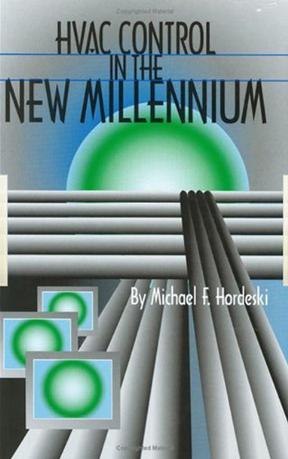
Content :-
Chapter 1 Heat, Ventilation and Damper Control Trends.
Chapter 1 introduces heat, ventilation and damper control trends as well as air conditioning trends. Basic concepts such as the properties of air, filtering and heat transfer are described. Zone control and year- around air conditioning are explained along with air washing. The concept of HVAC intelligence is introduced and advanced motion control for dampers including feedback devices, networking and PCs with digital drives are covered.
Chapter 2 Energy and Power Management, Distributed Control Trends.
Chapter 2 considers energy and power management trends. Distributed control levels include HVAC, communications and information management. Topics include direct digital control and proportional zone control. Future computer-based systems for intelligent buildings and controls may use biochemical computers.
Device communications for the intelligent I/O appliances used in complex adaptive systems may take place in industrial networks that use wireless connections.
Control technology and microelectronics are the main subjects of Chapter 3. After a summary of control modes and their characteristics, supervisory control techniques are considered for system optimization and old and new control concepts are compared. Advances in microelectronics push much of the new computer applications.
The computer evolution is due to shrinking devices. Nanotechnology will produce molecular and protein machines which are new types of molecular computers. Universal assemblers and disassemblers will build and rebuild future products. Reconfigurable computers with reconfigurable hardware are even closer in our future.
Chapter 4 Advanced HVAC Control, Information Technology and Open Systems.
Chapter 4 looks at advanced HVAC control, information technology and open systems trends. Semiconductor manufacturing involves advanced HVAC control concepts including air contamination, zone optimization, pressure control, flow control and pollution control. Intelligent alarms will use expert systems reasoning. Fault tolerant systems can use passive redundancy or active redundancy.Windows NT has become a de facto standard for control systems while Ethernet use has expanded as a plant control network. If feed forward is not used properly for HVAC, a number of errors can be propagated. This is explained in Chapter 4.Object technology is growing as it fuels open protocols and open control devices. This trend is producing open building controls.
Chapter 5 PC-based Control, Software and Bus Trends.
Chapter 6 Artificial Intelligence, Fuzzy Logic and Control.
Chapter 5 is concentrated on PC-based control, software and bus trends. Object concepts are explained along with trends in operating systems including Windows CE, Windows NT-2000, UNIX and Linux. ActiveX and Java are important tools in PC-based control, but the Internet remains as the key to the future. Future computers will use natural languages, chatter bots and voice recognition software. Search engines will become smarter as the web advances into the future. Smart software will use Bayesian Networks, personal slaves and wizards. Processing power depends on fabrication technology which has physical limitations. Chip multiprocessors are expected to proliferate in
the near future along with faster bus connections and products like wearable electronic displays.
the near future along with faster bus connections and products like wearable electronic displays.
Chapter 6 is concerned with artificial intelligence, fuzzy logic and control. This includes the different levels and areas of artificial intelligence including speech recognition systems, expert systems and neural networks. Fuzzy control can be used for temperature balancing or the overshoot that occurs during heat-up. Fuzzy control has been used to reduce the variability in product properties by 30% to 40%. Neural networks are being used in burner management systems for commercial power plants.
Chapter 7 Computer Networks and Security.
Chapter 7 is concerned with computer networks and security. The International Standards Organization model provides the functional layers for networking. Ethernet trends include wireless Ethernet. Internet enabled networks require security techniques such as digital certificates and passwords.
Chapter 8 Systems and Device Networks
Chapter 8 covers open systems and device networks. Building automation trends include the use of BACnet with its conformance classifications and interoperable functions. LonWorks control is an alternative and BACnet and LonMark may be used together. Other industrial networks include DeviceNet, CAN, ControlNet, Seriplex, AS-i, HART, Foundation Fieldbus, Profibus, CAB and MODBUS. Some of these networks require devices with healthy processing which makes them more
expensive than the control devices used in a typical commercial or institutional building for environmental control.
expensive than the control devices used in a typical commercial or institutional building for environmental control.
Chapter 9 Building Automation, Wireless Technology and the Internet.
Chapter 9 concentrates on building automation, wireless technology and the Internet. A variety of BACnet projects have been completed or are underway. There is a merging of information and control in building automation. This will continue as use of the Internet and wireless technology grow. The IrDA technology for infrared control may become prevalent. Cellular problems include security. The use of wireless LANs will grow along with the growth of pocket communications. Embedded Web pages may be included in many controllers for troubleshooting and maintenance. Personal digital assistants (PDAs), pagers and smart cell phones will share Windows data.
Smart antennas use their intelligence to sense the radio environment and optimize their performance. As Internet connections increase and the Internet grows, there will be new public networks that will reduce Internet bottlenecks. These new public networks will have added intelligence for configuration chores, managed backbones and security. Many thanks to Dee who kept this project moving along on schedule.



No comments:
Post a Comment